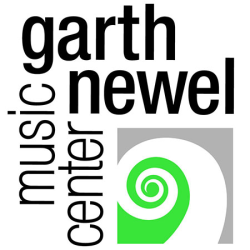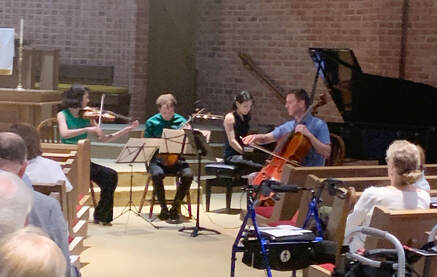 Garth Newel Piano Quartet Sunday, April 16, 2023 Orange Presbyterian Church Gustav Mahler: Piano Quartet in A minor David Biedenbender: Red Vesper Johannes Brahms: Piano Quartet No. 2 in A major, Op. 26 The Garth Newel Piano Quartet performed an engaging program at Orange Presbyterian Church. These are world-class musicians, so of course the playing was at the highest level. A pleasant surprise was the church's acoustics. The sanctuary's brick wall would seem a detraction. Audio waves bouncing off of hard surfaces tend to sound harsh. But the acoustics proved ideal for chamber music. The bricks' rough surfaces slightly diffused the sound, giving it more warmth. Plus, the ambiance of the space allowed the sound to travel. Reverberations were audible enough to further smooth the sound. But they weren't loud enough to muddy it. The sanctuary's Andrews Steinway piano received a workout. And it was up to the task. Jeannette Fang played the instrument with a full range of expression. She could make it whisper beautiful melodies or thunder massive chords with authority (and everything in between). The ensemble sound of the quartet was first-rate. These musicians know each other well and play with one accord. They embodied the highest ideal of chamber music. That is, to make the music seem like a spontaneous conversation between friends. The first half of the program featured a student work by Gustav Mahler. Composed in 1876, the Piano Quartet in A minor is a single-movement torso. Mahler abandoned the piece after completing just the first movement. Stylistically, the music embodied the emotional excess of the late-Romantic era. And so did the quartet in their performance. First violinist Teresa Ling played with a rich, dark tone that oozed emotional drama (or was that dramatic emotion?). The ensemble emphasized Mahler's melodic motifs each time they appeared. This helped guide the audience through this unfamiliar work. The power of the tutti unison at the end was thrilling to experience. Next was a short work by American composer David Biedenbender. Red Vesper evoked a spiritual moment in the woods. In this composition, silence was as important as sound. Biedenbender used both effectively. Most impressive were the rock-steady harmonics played by the strings. They're not easy to play. Yet the tones never wavered. And all three instruments were perfectly in tune with each other.  Johannes Brahms' Piano Quartet No. 2 in A major, Op. 26 made up the second half of the program. Brahms completed the second of his three piano quartets in 1861 when he was 27. As violist Fitz Gary pointed out in the introduction, the work is a mix of influences -- Beethoven, Schubert, Schumann, and Bach. Yet Brahms brings it all together in a cohesive whole lasting 50 minutes. Here the Garth Newel Piano Quartet really shone. They played the slow second movement with such delicate beauty that applause broke out at the end. It wasn't a breach of concert etiquette -- rather. it was a spontaneous response to the music. The performance was just that good. The quartet had a warm yet bright sound throughout the piece. And when the finale kicked in, the musicians cut loose. The finish was furiously fast and joyful. It was an exceptional afternoon of music-making. As the eighty-one people in the audience can enthusiastically attest. - Ralph Graves Program Director, CharlottesvilleClassical.org, host of "Classical Sunrise" on WTJU.net OPC Communications Team Leader
0 Comments
|
Archives
April 2024
Categories
All
|
